Popular categories
Looking for a yarn?

53% Cotton, 33% Viscose, 14% Linen
from 2.20 € /50g
Order DROPS Belle from Saules siulas
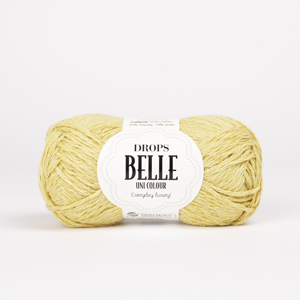
|
DROPS Belle uni colour 53% Cotton, 33% Viscose, 14% Linen |
2.20 € /50g |
Order |
Clicking the ORDER button will redirect you to Saules siulas website
Order DROPS Needles & Hooks
Clicking the ORDER button will redirect you to Saules siulas website
The yarn cost is calculated from the pattern’s smallest size and the yarn’s cheapest product type. Looking for an even better price? You might find it on the DROPS Deals!
Sweet History
Knitted jumper in DROPS Belle. Piece is knitted top down in stocking stitch with saddle shoulders. Size: S - XXXL
Change language:
English (UK/cm), Lithuania- English (UK/cm), Lithuania
- Česky
- Dansk
- Deutsch
- Eesti keel
- English (UK/cm)
- English (US/in)
- Español
- Français
- Íslenska
- Italiano
- Magyar
- Nederlands
- Norsk
- Polski
- Português
- Suomi
- Svenska
- English (UK/cm), Bulgaria
- English (UK/cm), Croatia
- English (UK/cm), Greece
- English (UK/cm), Latvia
- English (UK/cm), Romania
- English (UK/cm), Slovenia
- Česky, Slovakia
#sweethistorysweater
DROPS design: Pattern vs-087Yarn group B
----------------------------------------------------------
SIZE:
S - M - L - XL - XXL - XXXL
MATERIALS:
DROPS BELLE from Garnstudio (belongs to yarn group B)
400-450-500-550-600-650 g colour no 22, rose water
NEEDLES:
DROPS CIRCULAR NEEDLE SIZE 4 mm: Length 40 and 80 cm.
DROPS CIRCULAR NEEDLE SIZE 3 mm: Length 40 and 80 cm.
DROPS DOUBLE POINTED NEEDLES SIZE 4 mm
DROPS DOUBLE POINTED NEEDLES SIZE 3 mm
The technique MAGIC LOOP can be used – you then only need circular needle of 80 cm in each size.
KNITTING TENSION:
21 stitches in width and 28 rows vertically in stocking stitch = 10 x 10 cm.
NOTE! Remember that needle size is only a suggestion. If you have too many stitches on 10 cm switch to larger needles. If you have too few stitches on 10 cm switch to smaller needles.
-------------------------------------------------------
Alternative Yarn – See how to change yarns here
Yarn Groups A to F – Use the same pattern and change the yarn here
Yarn usage using an alternative yarn – Use our yarn converter here
-------------------------------------------------------
You might also like...

53% Cotton, 33% Viscose, 14% Linen
from 2.20 € /50g
Order DROPS Belle from Saules siulas

|
DROPS Belle uni colour 53% Cotton, 33% Viscose, 14% Linen 2.20 € /50g Order |
Clicking the ORDER button will redirect you to Saules siulas website
Order DROPS Needles & Hooks
Clicking the ORDER button will redirect you to Saules siulas website
The yarn cost is calculated from the pattern’s smallest size and the yarn’s cheapest product type. Looking for an even better price? You might find it on the DROPS Deals!
Pattern instructions
EXPLANATION FOR THE PATTERN:
----------------------------------------------------------
GARTER STITCH (back and forth):
Knit all rows.
1 ridge vertically = knit 2 rows.
PATTERN:
See diagrams A.1 and A.2.
INCREASE TIP-1 (evenly):
To calculate how to increase evenly, use the total number of stitches on row (e.g. 102 stitches) and divide stitches by number of increases to be done (e.g. 12) = 8.5.
In this example increase by making 1 yarn over after alternately every 8th and 9th stitch. On next round work yarn overs twisted to avoid holes.
INCREASE TIP-2:
BEFORE MARKER:
Work until stitch with marker,
The new stitch is twisted towards the right.
Use left needle to pick up yarn between 2 stitches from round below, pick up yarn from the back and knit stitch in front loop of stitch.
AFTER MARKER:
The new stitch is twisted towards the left.
Use left needle to pick up yarn between 2 stitches from round below, pick up yarn from the front and knit stitch in back loop of stitch.
DECREASE TIP-1(applies to front and back piece):
All decreases are done from the right side.
Work 1 edge stitch in garter stitch, slip 1 stitch knitwise, knit 1, pass slipped stitch over stitch worked(= 1 stitch decreased), work until 3 stitches remain, knit 2 together(= 1 stitch decreased), work 1 edge stitch in garter stitch.
DECREASE TIP-2 (applies to body and sleeves):
Work until 3 stitches remain before marker thread, knit 2 together (= 1 stitch decreased), knit 2 stitches (marker thread is between these stitches), slip 1 stitch knitwise, knit 1, pass slipped stitch over stitch worked (= 1 stitch decreased).
CAST-OFF TIP:
To avoid a tight cast-off edge when casting off, you may use a larger needle. If this still is too tight make 1 yarn over after approx. every 4th stitch while casting off (cast off yarn overs as stitches).
----------------------------------------------------------
START THE PIECE HERE:
----------------------------------------------------------
JUMPER - SHORT OVERVIEW OF THE PIECE:
Work neck edge in the round on a short circular needle. Work yoke in the round on circular needle until saddle shoulders are done. Then finish back piece and front piece back and forth on circular needle separately down until increase for armholes are done. Then slip front piece and back piece on to same circular needle and work body in the round on circular needle until finished measurements. Work sleeves first back and forth until sleeve cap is done, then work in the round on a short circular needle/double pointed needles the top and down. Sew in the sleeves as explained in pattern.
NECK EDGE:
Cast on 136-144-144-152-152-160 stitches on short circular needle size 3 mm with DROPS Belle. Knit 1 row from wrong side, turn piece and work in the round as follows: Work A.1 (= 17-18-18-19-19-20 repetitions of 8 stitches). When entire A.1 has been worked, there are 102-108-108-114-114-120 stitches on round.
Then work knit over knit and purl over purl until piece measures 4 cm at the shortest (where arches in the edge turns inwards in rib). Knit 1 round while increasing 12-10-10-8-8-6 stitches evenly - read INCREASE TIP-1 = 114-118-118-122-122-126 stitches.
YOKE:
Switch to circular needle size 4 mm.
Now insert 1 marker thread and 2 markers in the piece. Insert marker threads between 2 stitches and markers in a stitch as follows:
Insert 1 marker thread at beginning of round (= mid back), yoke is measured from this marker thread, skip the next 28-29-29-30-30-31 stitches, insert a marker in next stitch (= shoulder stitch), skip the next 56-58-58-60-60-62 stitches (= front piece), insert a marker in next stitch (= shoulder stitch), 28-29-29-30-30-31 stitches remain on round after last marker. Move markers upwards when working, increase on each side of stitches with markers.
SADDLE SHOULDER INCREASE:
Work in stocking stitch in the round.
AT THE SAME TIME on first round increase 4 stitches for saddle shoulder as follows:
Increase 1 stitch in each side of stitches with marker - READ INCREASE TIP-2. Increase only on front piece and back piece, and number of shoulder stitches (= 1 stitch) stays the same.
Continue in the round like this, and increase on every round 28-28-31-31-34-34 times in total = 226-230-242-246-258-262 stitches.
After last increase piece measures approx. 10-10-11-11-12-12 cm from marker thread by the neck
Work next round as follows from mid back:
Work the first 56-57-60-61-64-65 stitches (= half back piece), cast off stitch in the middle of shoulder, work the next 112-114-120-122-128-130 stitches before slipping them on a thread (= front piece), cast off stitch in the middle of shoulder, work the last 56-57-60-61-64-65 stitches (= half back piece). Cut the yarn.
BACK PIECE:
= 112-114-120-122-128-130 stitches.
Insert a marker here - NOW MEASURE PIECE FROM HERE!
Now work in stocking stitch with 1 edge stitch in GARTER STITCH - read explanation above, in each side. When 2 cm have been worked from division, decrease 1 stitch in each side of piece - read DECREASE TIP-1.
Decrease like this every other row 8-7-6-5-5-4 times in total = 96-100-108-112-118-122 stitches.
Continue to work until piece measures 17-17-18-19-18-17 cm. Now cast on stitches for armholes at the end of every row in each side as follows: Cast on 1 stitch 1-3-3-3-5-9 times = 98-106-114-118-128-140 stitches. Piece now measures 18-19-20-21-22-23 cm from marker. Cut the yarn, put piece aside and work the front piece.
FRONT PIECE:
Slip stitches from thread back on circular needle size 4 mm = 112-114-120-122-128-130 stitches. Work as on back piece. When increases for armholes are done, there are 98-106-114-118-128-140 stitches on the needle.
BODY:
Now work next row from right side as follows: Work in stocking stitch over all stitches on front piece, cast on 4-6-6-12-14-16 new stitches on needle (= in the side under sleeve), work in stocking stitch over stitches on back piece, cast on 4-6-6-12-14-16 new stitches on needle = 204-224-240-260-284-312 stitches for body.
Move the marker here – NOW MEASURE PIECE FROM HERE!
Insert a marker thread in the middle of the new stitches cast-on in the side under the sleeves (= 2-3-3-6-7-8 new stitches on each side of marker thread). Move the marker threads upwards when working; they are used for decreases in the sides later.
Continue in the round in stocking stitch. When piece measures 3 cm, decrease 1 stitch on each side of marker threads – read DECREASE TIP-2. Repeat decrease when piece measures 8-9-9-10-10-11 cm = 196-216-232-252-276-304 stitches. Work until piece measures 12-13-13-14-14-15 cm from marker. Try the jumper on and work until desired length (approx. 10 cm with rib remain before finished measurements). To stop the rib from contracting increase 32-36-38-42-48-50 stitches evenly = 228-252-270-294-324-354 stitches.
Switch to circular needle size 3 mm.
Now work rib (= knit 1/purl 1) for 4½ cm. Then work from arrow in diagram A.2. When A.2 has been worked vertically, continue with knit over knit and purl over purl until rib measures 10 cm in total. Cast off with knit over knit and purl over purl - read CAST-OFF TIP. Jumper measures approx. 50-52-54-56-58-60 cm (measured on the inside at the neck edge) and down.
SLEEVES:
Sleeve is worked top down.
Cast on 62-62-64-60-54-50 stitches on circular needle size 4 mm with DROPS Belle (cast on fewer stitches in the larger sizes because of more increases in each side for sleeve cap). Work stocking stitch back and forth, at the same time cast on stitches at the end of every row in each side as follows: Cast on 3-1-1-1-1-1 stitches 1-4-4-5-8-11 times, then on next row from right side, cast on 4-6-6-12-14-16 stitches = 72-76-78-82-84-88 stitches. Insert a marker thread in the middle of the 4-6-6-12-14-16 stitches that were cast on under sleeve (= mid under sleeve). Move marker thread upwards when working. Use it later when decreasing under sleeve. NOW MEASURE PIECE FROM HERE!
Begin round at the marker thread and work stocking stitch in the round on a short circular needle/double pointed needles size 4 mm. When piece measures 4 cm, decrease 1 stitch on each side of both marker threads – remember DECREASE TIP-2. In size M, L and XXXL, repeat decrease when piece measures 10 cm = 70-72-74-80-82-84 stitches. Continue to work in stocking stitch until sleeve measures 27-25-25-23-21-19 cm.
Now insert a new marker thread in the middle of sleeve so that there are 35-36-37-40-41-42 stitches between the 2 marker threads. Work stocking stitch in the round, at the same time decrease 1 stitch on each side of both marker threads - remember DECREASE TIP-2. Decrease like this every 4th round 7-7-7-8-8-8 times = 42-44-46-48-50-52 stitches.
Work in stocking stitch until sleeve measures approx. 37-35-35-34-32-30 cm – or desired length (approx. 10 cm now remain with rib until finished measurements and shorter measurements in the larger sizes because of wider shoulders).
Knit 1 round while increasing 6-4-8-6-10-8 stitches evenly = 48-48-54-54-60-60 stitches.
Switch to double pointed needles size 3 mm.
Work rib (knit 1/purl 1) in the round for 4½ cm. Now work from round with arrow in A.2 in the round. When A.2 has been worked, work rib until rib measures 10 cm in total. Cast off with knit over knit and purl over purl - remember CAST-OFF TIP. Work the other sleeve the same way.
ASSEMBLY:
Sew sleeves in body inside 1 edge stitch in garter stitch on body and inside cast-on edge on sleeves.
Diagram

|
= knit |

|
= purl |

|
= between 2 stitches make 1 yarn over. On next round knit yarn overs to make holes |

|
= knit 3 together |

|
= begin on this round in diagrams |

|
= between 2 stitches make 1 yarn over. On next round work yarn over twisted to avoid holes |

|
= knit 6 together |
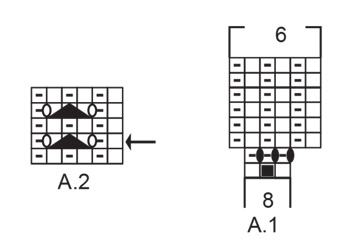
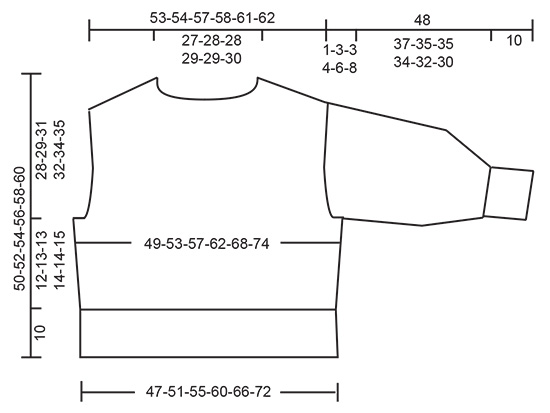
What can you do with our patterns? You can share DROPS patterns online, using the pattern original picture, materials, name and number. But you are NOT ALLOWED to reproduce the complete pattern digitally in any way. Yarn stores are welcome to use the DROPS pattern database to promote the sale of our assortment. You can print out our patterns, make as many copies as you’d like. The only thing we ask is that you don't make any changes / additions to the original printed document. And that the patterns according to the DROPS philosophy are given out to the consumers for free. Editorials that wish to publish our patterns in printed books or magazines can contact us for more information. The sale of garments based on DROPS patterns is permitted as long as they are sold as single items or per order. Further commercial use of the patterns is not permitted. It has to be clearly stated that the garment is made based on a design from DROPS DESIGN. The use of clothing labels of which DROPS DESIGN forms part is conditioned by the inclusion of the following text: “A DROPS DESIGN made by …..”. The use of DROPS photos for marketing purposes/sales is only permitted in connection with the use/sale of DROPS products. The photos may not be cut or edited and the logo should be clearly visible.
We reserve the right to withdraw the permission for use of our patterns at any time, notwithstanding the reason.
Each of our patterns has specific tutorial videos to help you.
These step-by-step tutorials might also help you:
Why is the knitting/crochet tension so important?
Knitting tension is what determines the final measurements of your work, and is usually measured per 10 x 10 cm. It is provided like so: number of stitches in width x number of rows in height - eg: 19 stitches x 26 rows = 10 x 10 cm.
The knitting tension is very individual; some people knit/crochet loosely while others work tightly. You adjust the knitting tension with the needle size, which is why the suggested needle size is only meant as a guide! You need to adjust this (up or down) to ensure that YOUR knitting tension matches the knitting tension provided in the pattern. If you work with a different knitting tension than provided you will have a different yarn consumption, and your work will have different measurements than what the pattern suggests.
The knitting tension also determines which yarns can replace each other. As long as you achieve the same knitting tension you can replace one yarn with another.
See DROPS lesson: How to measure your tension/gauge
See DROPS video: How to make a gauge tension swatch
How do I know how many balls of yarn I need?
The required amount of yarn is provided in grams, eg: 450 g. To calculate how many balls you’ll need you first need to know how many grams are in 1 ball (25g, 50g or 100g). This information is available if you click on the individual yarn quality on our pages. Divide the amount required with the amount of each ball. For example, if each ball is 50g (the most common amount), the calculation will be as follows: 450 / 50 = 9 balls.
Can I use a different yarn than what the pattern suggests?
The important thing when changing from one yarn to another is that the knitting/crochet tension remains the same. This is so that the measurements of the finished piece will be the same as on the sketch provided. It is easier to achieve the same knitting tension using yarns from the same yarn group. It is also possible to work with multiple strands of a thinner yarn to achieve the knitting tension of a thicker one. Please try our yarn converter. We recommend you to always work a test swatch.
Please NOTE: when changing yarn the garment might have a different look and feel to the garment in the photo, due to individual properties and qualities of each yarn.
See DROPS lesson: Can I use a different yarn than the one mentioned in the pattern?
What are the yarn groups?
All our yarns are categorised into yarn groups (from A to F) according to thickness and knitting tension – group A contains the thinnest yarns and group F the thickest. This makes it easier for you to find alternative yarns to our patterns, should you wish to switch yarn. All yarns within the same group have a similar knitting tension and can easily replace each other. However, different yarn qualities have different structures and properties which will give the finished work a unique look and feel.
How do I use the yarn calculator?
At the top of all our patterns you’ll find a link to our yarn calculator, which is a helpful tool should you wish to use a different yarn than suggested. By filling in the yarn quality you wish to replace, the amount (in your size) and number of strands, the calculator will present good alternative yarns with the same knitting tension. Additionally it will tell you how much you’ll require in the new qualities and whether you’ll need to work with multiple strands. Most skeins are 50g (some are 25g or 100g).
If the pattern is worked with multiple colours, every colour will have to be calculated separately. Similarly, if the pattern is worked with several strands of different yarns (for example 1 strand Alpaca and 1 strand Kid-Silk) you will have to find alternatives for each, individually.
Why do you show discontinued yarns in the patterns?
Since different yarns have different qualities and textures we have chosen to keep the original yarn in our patterns. However, you can easily find options among our available qualities by using our yarn calculator, or simply pick a yarn from the same yarn group.
It is possible that some retailers still have discontinued yarns in stock, or that someone has a few skeins at home that they would like to find patterns for.
The yarn calculator will provide both alternative yarn as well as required amount in the new quality.
What size should I knit?
If you think it's hard to decide what size to make, it can be a good idea to measure a garment you own already and like the size of. Then you can pick the size by comparing those measures with the ones available in the pattern's size chart.
You'll find the size chart at the bottom of the pattern.
See DROPS lesson: How to read size chart
Why do I get the wrong knitting tension with the suggested needle size?
The needle size provided in the pattern serves only as a guide, the important thing is to follow the knitting tension. And since knitting tension is very individual, you will have to adjust the needle size to ensure that YOUR tension is the same as in the pattern – maybe you’ll have to adjust 1, or even 2 needle sizes, up or down to achieve the correct tension. For this, we recommend that you work test swatches.
Should you work with a different knitting tension than the one provided, the measurements of the finished garment might deviate from the measurement sketch.
See DROPS lesson: How to measure your tension/gauge
See DROPS video: How to make a tension/gauge swatch
Why is the pattern worked top-down?
Working a garment top-down provides more flexibility and room for personal adjustment. For example it is easier to try the garment on while working, as well as making adjustments to length of yoke and shoulder caps.
The instructions are carefully explaining every step, in the correct order. Diagrams are adjusted to the knitting direction and are worked as usual.
How do I work according to a knitting diagram?
The diagram depicts all rows/rounds, and every stitch seen from the right side. It is read from bottom to top, from right to left. 1 square = 1 stitch.
When working back and forth, every other row is worked from the right side and every other row is worked from the wrong side. When working from the wrong side, the diagram will have to be worked reversed: from left to right, knit stitches are purled, purl stitches are knit etc.
When working in the round every round is worked from the right side and the diagram are worked from right to left on all rounds.
See DROPS lesson: How to read knitting diagrams
How do I work according to a crochet diagram?
The diagram depicts all rows/rounds, and every stitch seen from the right side. It is worked from bottom to top, from right to left.
When working back and forth every other row is worked from the right side: from right to left and every other row is worked from the wrong side: from left to right.
When working in the round, every row in the diagram are worked from the right side, from right to left.
When working a circular diagram you start in the middle and work your way outwards, counter clockwise, row by row.
The rows usually start with a given number of chain stitches (equivalent to the height of the following stitch), this will either be depicted in the diagram or explained in the pattern.
See DROPS lesson: How to read crochet diagrams
How do I work several diagrams simultaneously on the same row/round?
Instructions for working several diagrams after each other on the same row/round, will often be written like so: “work A.1, A.2, A.3 a total of 0-0-2-3-4 times". This means you work A.1 once, then A.2 is worked once, and A.3 is repeated (in width) the number of times provided for your size – in this case like so: S = 0 times, M = 0 times, L=2 times, XL= 3 times and XXL = 4 times.
The diagrams are worked as usual: begin with the first row in A.1, then work the first row in A.2 etc.
See DROPS lesson: How to read knitting diagrams
See DROPS lesson: How to read crochet diagrams
Why are the sleeves shorter in larger sizes?
The total width of the garment (from wrist-to-wrist) will be larger in the larger sizes, despite the actual sleeves being shorter. The larger sizes have longer sleeve caps and wider shoulders, so there will be a good fit in all sizes.
Where on the garment is the length measured?
The measurement sketch/schematic drawing provides information regarding the full length of the garment. If it’s a jumper or a jacket the length is measured from the highest point on the shoulder closest to the neckline, and straight down to the bottom of the garment. It is NOT measured from the tip of shoulder. Similarly, the length of yoke is measured from the highest point on the shoulder and down to where yoke is split into body and sleeves.
On a jacket measures are never taken along bands, unless specifically stated. Always measure inside band stitches when measuring the length.
See DROPS lesson: How to read a schematic drawing
What is a repeat?
Diagrams are often repeated on the round or in height. 1 repeat is the diagram the way it appears in the pattern. If it says to work 5 repeats of A.1 in the round, then you work A.1 a total of 5 times after/next to each other in the round. If it says to work 2 repeats of A.1 vertically/in height you work the entire diagram once, then begin again at the start and work the entire diagram one more time.
Why does the piece start with more chain stitches than it’s worked with?
Chain stitches are slightly narrower than other stitches and to avoid working the cast-on edge too tight, we simply chain more stitches to begin with. The stitch count will be adjusted on the following row to fit the pattern and measurement sketch.
Why increase before the rib edge when the piece is worked top-down?
The rib edge is more elastic and will contract slightly compared to, for example, stocking stitch. By increasing before the rib edge, you avoid a visible difference in width between the rib edge and the rest of the body.
Why increase in the cast-off edge?
It’s very easy to cast off too tightly, and by making yarn overs while casting off (and simultaneously casting these off) you avoid a too tight cast off edge.
See DROPS video: How to bind off with yarn overs (yo)
How do I increase/decrease on every 3rd and 4th row/round alternately?
To achieve an even increase (or decrease) you can increase on, for example: every 3rd and 4th row alternately, like so: work 2 rows and increase on the 3rd row, work 3 rows and increase on the 4th. Repeat this until the increase is complete.
See DROPS lesson: Increase or decrease 1 st on every 3rd and 4th row alternately
How can I work a jacket in the round instead of back and forth?
Should you prefer to work in the round instead of back and forth, you may of course adjust the pattern. You’ll need to add steeks mid-front (usually 5 stitches), and follow the instructions. When you would normally turn and work from the wrong side, simply work across the steek and continue in the round. At the end you’ll cut the piece open, pick up stitches to work bands, and cover the cut edges.
See DROPS video: How to knit steeks and cut open
Can I work a jumper back and forth instead of in the round?
Should you prefer to work back and forth instead of in the round, you may of course adjust the pattern so you work the pieces separately and then assemble them at the end. Divide the stitches for the body in 2, add 1 edge stitch in each side (for sewing) and work the front and back pieces separately.
See DROPS lesson: Can I adapt a pattern for circular needles into straight needles?
Why is the pattern slightly different than what I see in the photo?
Pattern repeats can vary slightly in the different sizes, in order to get the correct proportions. If you’re not working the exact same size as the garment in the photo, yours might deviate slightly. This has been carefully developed and adjusted so that the complete impression of the garment is the same in all sizes.
Make sure to follow instructions and diagrams for your size!
How do I make a women’s size garment into a men’s size one?
If you have found a pattern you like which is available in women’s size it’s not very difficult to convert it to men’s size. The biggest difference will be the length of sleeves and body. Start working on the women size that you think would fit across the chest. The additional length will be worked right before you cast off for the armhole/sleeve cap. If the pattern is worked top-down you can add the length right after the armhole or before the first decrease on sleeve.
Regarding additional yarn amount, this will depend on how much length you add, but it is better with a skein too many than too few.
How do I prevent a hairy garment from shedding?
All yarns will have excess fibres (from production) that might come off as lint or shedding. Brushed yarns (ie hairier yarns) have more of these loose, excess fibres, causing more shedding.
Shedding also depends on what is worn under or over the garment, and whether this pulls at the yarn fibres. It’s therefore not possible to guarantee that there will be no shedding
Below are some tips on how to get the best result when working with hairier yarns:
1. When the garment is finished (before you wash it) shake it vigorously so the looser hairs come off. NOTE: do NOT use a lint roller, brush or any method that pulls at the yarn.
2. Place the garment in a plastic bag and put it in your freezer - the temperature will cause the fibres to become less attached to each other, and excess fibres will come off easier.
3. Leave in the freezer for a few hours before taking it out and shaking it again.
4. Wash the garment according to the instructions on the yarn label.
Why does my garment pill?
Pilling is a natural process that happens to even the most exclusive of fibers. It's a natural sign of wear and tear that is hard to avoid, and that is most visible in high friction areas of your garment like a sweater's arms and cuffs.
You can make your garment look as new by removing the pilling, using a fabric comb or a pill/lint remover.
In the meantime, you can read the questions and answers that others have left to this pattern or join the DROPS Workshop on Facebook to get help from fellow knitters/crocheters!
Sweet History |
||||||||||||||||||||||
 |
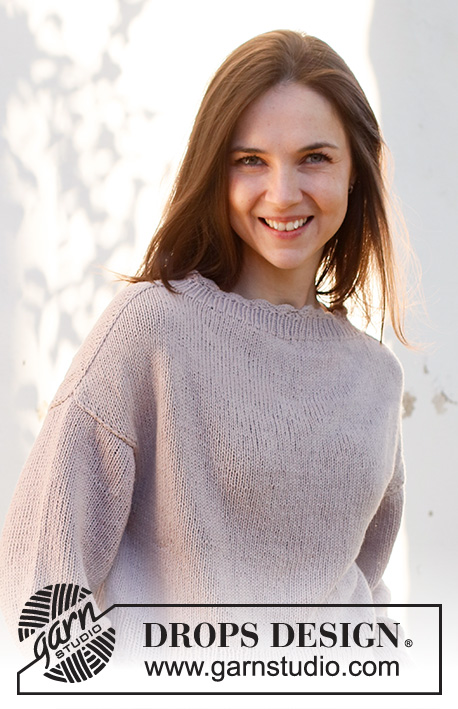 |
|||||||||||||||||||||
Knitted jumper in DROPS Belle. Piece is knitted top down in stocking stitch with saddle shoulders. Size: S - XXXL
DROPS 232-44 |
||||||||||||||||||||||
|
---------------------------------------------------------- EXPLANATION FOR THE PATTERN: ---------------------------------------------------------- GARTER STITCH (back and forth): Knit all rows. 1 ridge vertically = knit 2 rows. PATTERN: See diagrams A.1 and A.2. INCREASE TIP-1 (evenly): To calculate how to increase evenly, use the total number of stitches on row (e.g. 102 stitches) and divide stitches by number of increases to be done (e.g. 12) = 8.5. In this example increase by making 1 yarn over after alternately every 8th and 9th stitch. On next round work yarn overs twisted to avoid holes. INCREASE TIP-2: BEFORE MARKER: Work until stitch with marker, The new stitch is twisted towards the right. Use left needle to pick up yarn between 2 stitches from round below, pick up yarn from the back and knit stitch in front loop of stitch. AFTER MARKER: The new stitch is twisted towards the left. Use left needle to pick up yarn between 2 stitches from round below, pick up yarn from the front and knit stitch in back loop of stitch. DECREASE TIP-1(applies to front and back piece): All decreases are done from the right side. Work 1 edge stitch in garter stitch, slip 1 stitch knitwise, knit 1, pass slipped stitch over stitch worked(= 1 stitch decreased), work until 3 stitches remain, knit 2 together(= 1 stitch decreased), work 1 edge stitch in garter stitch. DECREASE TIP-2 (applies to body and sleeves): Work until 3 stitches remain before marker thread, knit 2 together (= 1 stitch decreased), knit 2 stitches (marker thread is between these stitches), slip 1 stitch knitwise, knit 1, pass slipped stitch over stitch worked (= 1 stitch decreased). CAST-OFF TIP: To avoid a tight cast-off edge when casting off, you may use a larger needle. If this still is too tight make 1 yarn over after approx. every 4th stitch while casting off (cast off yarn overs as stitches). ---------------------------------------------------------- START THE PIECE HERE: ---------------------------------------------------------- JUMPER - SHORT OVERVIEW OF THE PIECE: Work neck edge in the round on a short circular needle. Work yoke in the round on circular needle until saddle shoulders are done. Then finish back piece and front piece back and forth on circular needle separately down until increase for armholes are done. Then slip front piece and back piece on to same circular needle and work body in the round on circular needle until finished measurements. Work sleeves first back and forth until sleeve cap is done, then work in the round on a short circular needle/double pointed needles the top and down. Sew in the sleeves as explained in pattern. NECK EDGE: Cast on 136-144-144-152-152-160 stitches on short circular needle size 3 mm with DROPS Belle. Knit 1 row from wrong side, turn piece and work in the round as follows: Work A.1 (= 17-18-18-19-19-20 repetitions of 8 stitches). When entire A.1 has been worked, there are 102-108-108-114-114-120 stitches on round. Then work knit over knit and purl over purl until piece measures 4 cm at the shortest (where arches in the edge turns inwards in rib). Knit 1 round while increasing 12-10-10-8-8-6 stitches evenly - read INCREASE TIP-1 = 114-118-118-122-122-126 stitches. YOKE: Switch to circular needle size 4 mm. Now insert 1 marker thread and 2 markers in the piece. Insert marker threads between 2 stitches and markers in a stitch as follows: Insert 1 marker thread at beginning of round (= mid back), yoke is measured from this marker thread, skip the next 28-29-29-30-30-31 stitches, insert a marker in next stitch (= shoulder stitch), skip the next 56-58-58-60-60-62 stitches (= front piece), insert a marker in next stitch (= shoulder stitch), 28-29-29-30-30-31 stitches remain on round after last marker. Move markers upwards when working, increase on each side of stitches with markers. SADDLE SHOULDER INCREASE: Work in stocking stitch in the round. AT THE SAME TIME on first round increase 4 stitches for saddle shoulder as follows: Increase 1 stitch in each side of stitches with marker - READ INCREASE TIP-2. Increase only on front piece and back piece, and number of shoulder stitches (= 1 stitch) stays the same. Continue in the round like this, and increase on every round 28-28-31-31-34-34 times in total = 226-230-242-246-258-262 stitches. After last increase piece measures approx. 10-10-11-11-12-12 cm from marker thread by the neck Work next round as follows from mid back: Work the first 56-57-60-61-64-65 stitches (= half back piece), cast off stitch in the middle of shoulder, work the next 112-114-120-122-128-130 stitches before slipping them on a thread (= front piece), cast off stitch in the middle of shoulder, work the last 56-57-60-61-64-65 stitches (= half back piece). Cut the yarn. BACK PIECE: = 112-114-120-122-128-130 stitches. Insert a marker here - NOW MEASURE PIECE FROM HERE! Now work in stocking stitch with 1 edge stitch in GARTER STITCH - read explanation above, in each side. When 2 cm have been worked from division, decrease 1 stitch in each side of piece - read DECREASE TIP-1. Decrease like this every other row 8-7-6-5-5-4 times in total = 96-100-108-112-118-122 stitches. Continue to work until piece measures 17-17-18-19-18-17 cm. Now cast on stitches for armholes at the end of every row in each side as follows: Cast on 1 stitch 1-3-3-3-5-9 times = 98-106-114-118-128-140 stitches. Piece now measures 18-19-20-21-22-23 cm from marker. Cut the yarn, put piece aside and work the front piece. FRONT PIECE: Slip stitches from thread back on circular needle size 4 mm = 112-114-120-122-128-130 stitches. Work as on back piece. When increases for armholes are done, there are 98-106-114-118-128-140 stitches on the needle. BODY: Now work next row from right side as follows: Work in stocking stitch over all stitches on front piece, cast on 4-6-6-12-14-16 new stitches on needle (= in the side under sleeve), work in stocking stitch over stitches on back piece, cast on 4-6-6-12-14-16 new stitches on needle = 204-224-240-260-284-312 stitches for body. Move the marker here – NOW MEASURE PIECE FROM HERE! Insert a marker thread in the middle of the new stitches cast-on in the side under the sleeves (= 2-3-3-6-7-8 new stitches on each side of marker thread). Move the marker threads upwards when working; they are used for decreases in the sides later. Continue in the round in stocking stitch. When piece measures 3 cm, decrease 1 stitch on each side of marker threads – read DECREASE TIP-2. Repeat decrease when piece measures 8-9-9-10-10-11 cm = 196-216-232-252-276-304 stitches. Work until piece measures 12-13-13-14-14-15 cm from marker. Try the jumper on and work until desired length (approx. 10 cm with rib remain before finished measurements). To stop the rib from contracting increase 32-36-38-42-48-50 stitches evenly = 228-252-270-294-324-354 stitches. Switch to circular needle size 3 mm. Now work rib (= knit 1/purl 1) for 4½ cm. Then work from arrow in diagram A.2. When A.2 has been worked vertically, continue with knit over knit and purl over purl until rib measures 10 cm in total. Cast off with knit over knit and purl over purl - read CAST-OFF TIP. Jumper measures approx. 50-52-54-56-58-60 cm (measured on the inside at the neck edge) and down. SLEEVES: Sleeve is worked top down. Cast on 62-62-64-60-54-50 stitches on circular needle size 4 mm with DROPS Belle (cast on fewer stitches in the larger sizes because of more increases in each side for sleeve cap). Work stocking stitch back and forth, at the same time cast on stitches at the end of every row in each side as follows: Cast on 3-1-1-1-1-1 stitches 1-4-4-5-8-11 times, then on next row from right side, cast on 4-6-6-12-14-16 stitches = 72-76-78-82-84-88 stitches. Insert a marker thread in the middle of the 4-6-6-12-14-16 stitches that were cast on under sleeve (= mid under sleeve). Move marker thread upwards when working. Use it later when decreasing under sleeve. NOW MEASURE PIECE FROM HERE! Begin round at the marker thread and work stocking stitch in the round on a short circular needle/double pointed needles size 4 mm. When piece measures 4 cm, decrease 1 stitch on each side of both marker threads – remember DECREASE TIP-2. In size M, L and XXXL, repeat decrease when piece measures 10 cm = 70-72-74-80-82-84 stitches. Continue to work in stocking stitch until sleeve measures 27-25-25-23-21-19 cm. Now insert a new marker thread in the middle of sleeve so that there are 35-36-37-40-41-42 stitches between the 2 marker threads. Work stocking stitch in the round, at the same time decrease 1 stitch on each side of both marker threads - remember DECREASE TIP-2. Decrease like this every 4th round 7-7-7-8-8-8 times = 42-44-46-48-50-52 stitches. Work in stocking stitch until sleeve measures approx. 37-35-35-34-32-30 cm – or desired length (approx. 10 cm now remain with rib until finished measurements and shorter measurements in the larger sizes because of wider shoulders). Knit 1 round while increasing 6-4-8-6-10-8 stitches evenly = 48-48-54-54-60-60 stitches. Switch to double pointed needles size 3 mm. Work rib (knit 1/purl 1) in the round for 4½ cm. Now work from round with arrow in A.2 in the round. When A.2 has been worked, work rib until rib measures 10 cm in total. Cast off with knit over knit and purl over purl - remember CAST-OFF TIP. Work the other sleeve the same way. ASSEMBLY: Sew sleeves in body inside 1 edge stitch in garter stitch on body and inside cast-on edge on sleeves. |
||||||||||||||||||||||
Diagram explanations |
||||||||||||||||||||||
|
||||||||||||||||||||||

|
||||||||||||||||||||||

|
||||||||||||||||||||||
|
Have you made this or any other of our designs? Tag your pictures in social media with #dropsdesign so we can see them! Do you need help with this pattern?You'll find tutorial videos, a Comments/Questions area and more by visiting the pattern on garnstudio.com. © 1982-2024 DROPS Design A/S. We reserve all rights. This document, including all its sub-sections, has copyrights. Read more about what you can do with our patterns at the bottom of each pattern on our site. |
||||||||||||||||||||||
With over 40 years in knitting and crochet design, DROPS Design offers one of the most extensive collections of free patterns on the internet - translated to 17 languages. As of today we count 309 catalogues and 11629 patterns translated into English (UK/cm). 11629
We work hard to bring you the best knitting and crochet have to offer, inspiration and advice as well as great quality yarns at incredible prices! Would you like to use our patterns for other than personal use? You can read what you are allowed to do in the Copyright text at the bottom of all our patterns. Happy crafting!








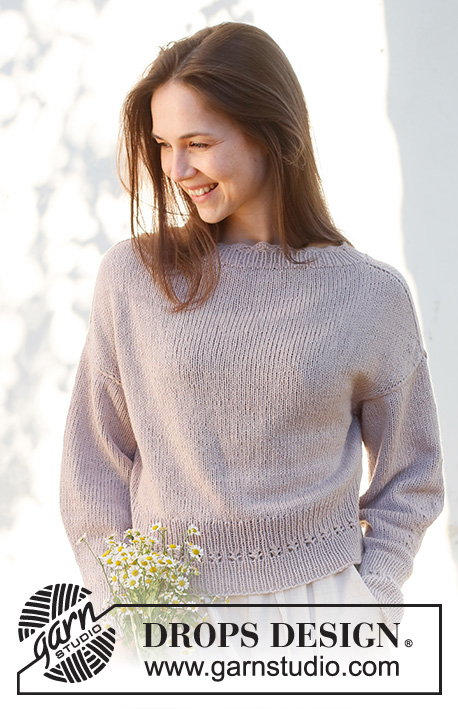


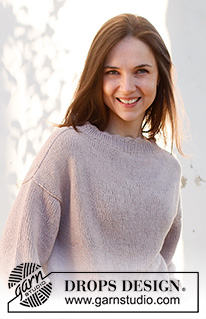
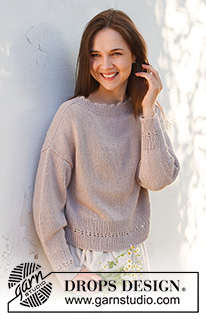
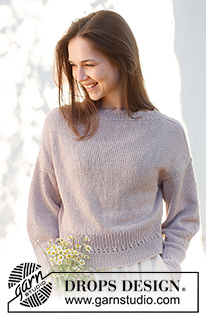
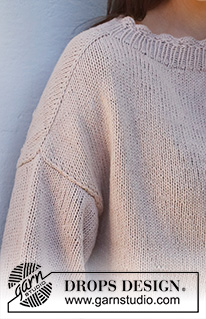



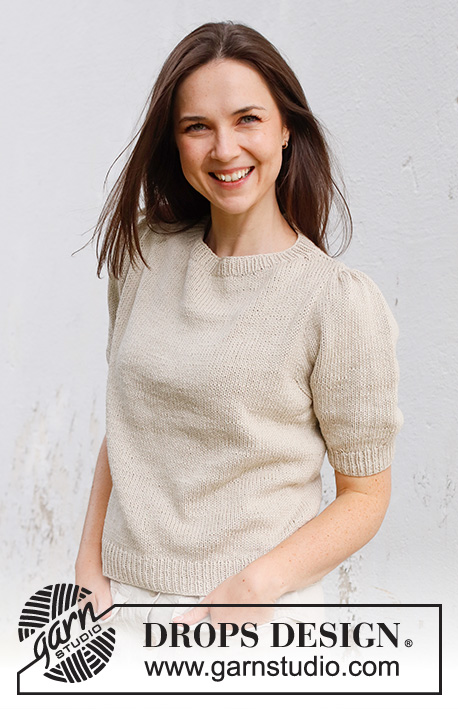
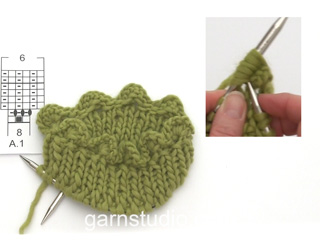
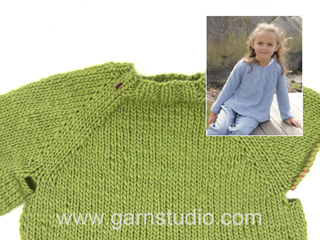
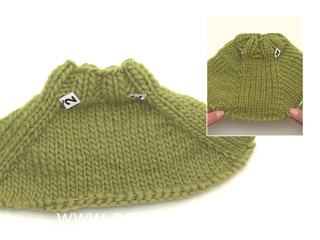

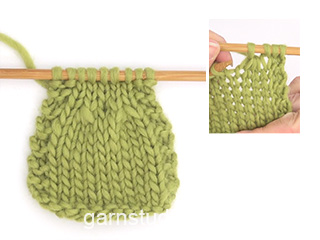

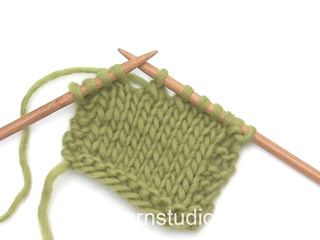


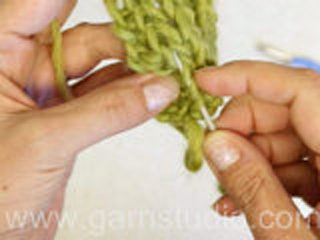
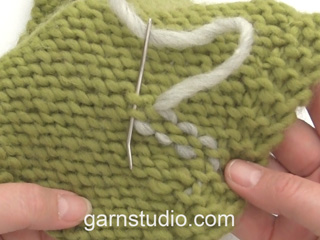
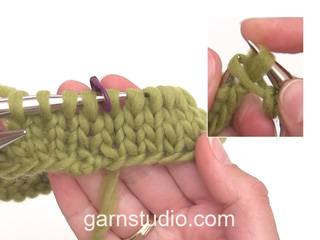

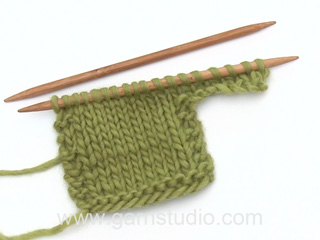

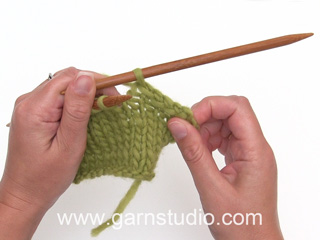
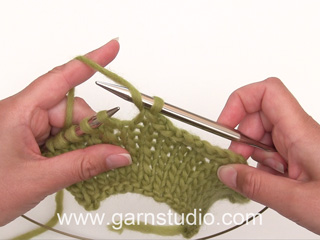


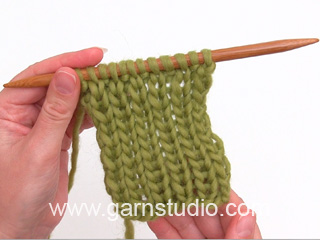
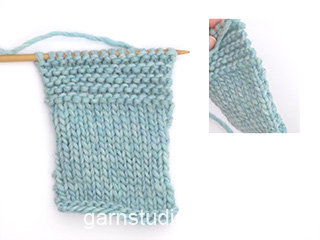
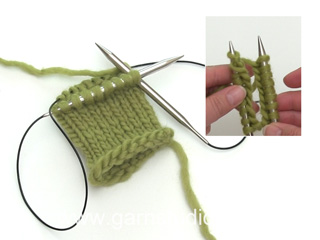

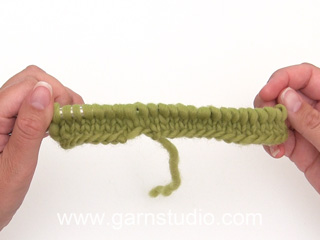
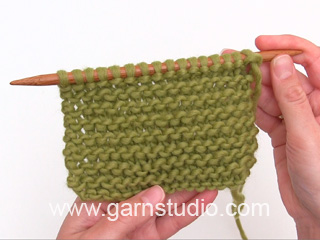
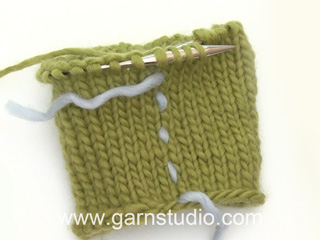
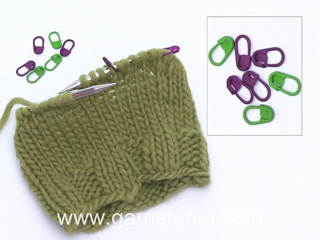










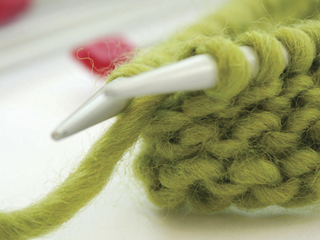






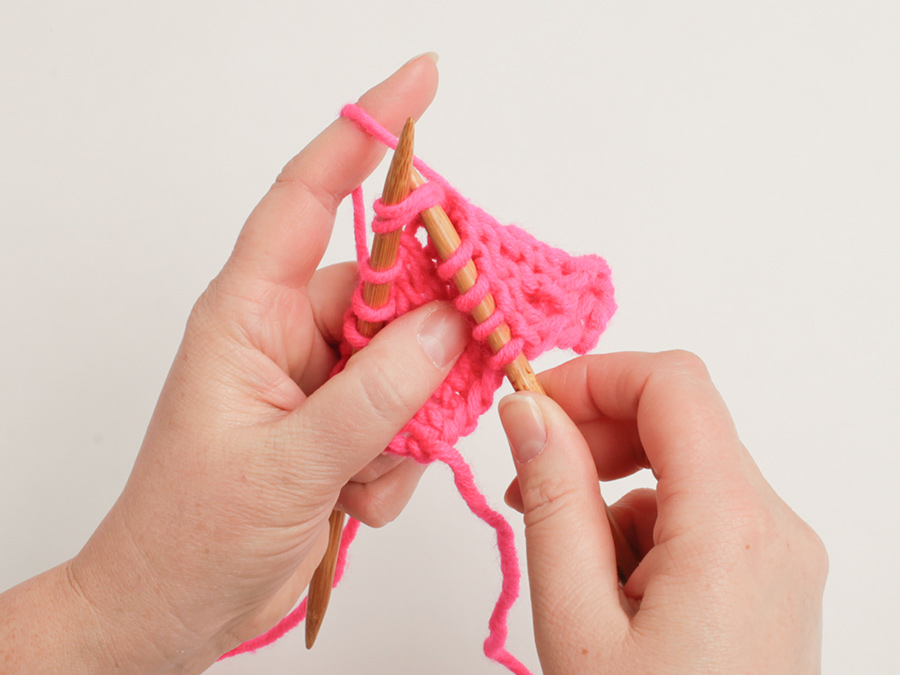







Comments / Questions (11)
Las instrucciones para la orilla del cuello, no son correctas, ya que despues de tener 18 arcos, con 2 puntos en promedio, dan como resultado 54 puntos para el cuello, no 108, como dicen las instrucciones. Por favor CORREGIR¡.
21.04.2024 - 19:48Bonjour, Je tricote le modèle en taille S. J’ai terminé le dos / devant qui correspond aux mesures indiquées. Le montage de la manche est problématique, 72mailles après les augmentations pour commencer à tricoter en rond ne sont pas suffisantes. Il manque une vingtaine de mailles sur le haut de manche pour correspondre à l’emmanchure. Pourriez-vous vérifier le montage de la manche? Je peux vous envoyer une photo si nécessaire ;o) en vous remerciant par avance, d.
01.01.2024 - 19:56Ich bin am verzweifeln, ich bekomme die Ärmel einfach nicht schön eingenäht . Es sind viel mehr Maschen am Schulter Teil als wie bei dem Ärmel , ich konnte einen schon annähen von weiten sah es ok aus aber bei genauen hinsehen sieht die Naht einfach nicht schön aus weil es nicht gleichmäßig ist . Ein Video wie man diesen Ärmel einnähen soll wäre hilfreich
12.11.2023 - 16:56DROPS Design answered:
Liebe Petra, die letzten 4-6-6-12-14-16 angeschlagenen Maschen beim Ärmel werden an den 4-6-6-12-14-16 Maschen, die zwischen Vorder- und Rückenteil angeschlagen wurden, dann die restlichen Maschen am oberen Teil vom Armkugel werden am Armausschnitt angenäht. Viel Spaß beim fertigstellen!
13.11.2023 - 08:23Ich habe jetzt die Ärmel so gestrickt wie in meiner Frage beschrieben. Die Maschen nach dem Faden haben 5 Reihen , die Maschen hinter dem Faden aber schon 6 Reihen . Denn die Masche wo ich anfangen musste in runden zu stricken haben ja mehr Reihen als die letzten zwei vierer maschen , weil die noch nicht gestrickt wurden , aber jetzt als neue Runde zählen. Wenn ich über die letzten zwei gehe wäre es wieder der normale runden Anfang und nicht der neue runden Beginn.
07.11.2023 - 16:01DROPS Design answered:
Liebe Petra, stimmt, es wird 1 Reihe/Runde unterschied aber dies wird nicht sichtbar. Nach den neuen Maschen, legen Sie die Arbeit in Runden, dh stricken Sie die ersten Maschen von der Hinreihe bis die 2 letzten neuen Maschen, setzen Sie eine Markierung hier für den Rundbeginn. Viel Spaß beim stricken!
08.11.2023 - 07:52Ich bin jetzt bei den Ärmeln in Größe S : ich habe beidseitig 3 Maschen zugenommen, jetzt muss ich in der nächsten vier Maschen anschlagen und in runden Stricken. Verbinde ich die 4 Maschen mit der ersten Masche von den drei von vorhin , denn wie soll die Runde bei der ersten Masche nach dem Makierungsfaden sein , oder ist das egal das es eigentlich der Anfang wo anders ist und es wird ab dem Makierungsfaden das als Anfang gesehen ?
07.11.2023 - 10:36DROPS Design answered:
Liebe Petra, am Ende einer Hin-Reihe schlagen Sie die 4 neuen Maschen an, dann stricken Sie in der Runde bis in der Mitte von diesem 4 Maschen, die Runden beginnen dann hier. Der Markierungsfaden setzen Sie in der Mitte von diesen 4 Maschen. Viel Spaß beim stricken!
07.11.2023 - 13:34Ich bin gerade bei dem Schritt nachdem man die letzten 56 Maschen strickt (halbes Rücken teil ) jetzt steht ich soll den Faden abscheiden . Muss ich also dann mit einem neun paar Nadeln ganz am Rand anfangen um hin und zurück zu Stricken ? Oder wo soll ich mit dem Rückenteil anfangen?
31.10.2023 - 12:29DROPS Design answered:
Liebe Petra, jetzt stricken Sie alle Maschen von Rückenteil, so die Hälfte der Maschen (56) heben Sie ab und setzen Sie mit der anderen Hälfte vom Rückenteil, so können Sie die 112 Maschen vom Rückenteil stricken. Viel Spaß beim stricken!
31.10.2023 - 16:22Guten Tag, Wann schließe ich bei den Ärmeln zur Runde? Ich setze den Markierungsfaden zwischen die sechs neuen Maschen. Dort soll ich die Runde beginnen. Was ist mit den anderen 3 Maschen? Vielen Dank für Ihre Hilfe und die vielen tollen Anleitungen und Videos!
09.03.2023 - 10:19DROPS Design answered:
Liebe Frau Vögeding, wenn alle Maschen angeschlagen sind, dh wenn die letzten 6 Maschen am Ende der letzten Hinreihe angeschlagen sind stricken Sie jetzt in der Runde. Der Markierungsfaden setzen Sie in der Mitte von diesen 6 Maschen = neue Rundbeginn. Viel Spaß beim stricken!
09.03.2023 - 12:15Hallo, für dieses Modell würde ich gerne das Garn " soft Tweed"verwenden, da ich davon noch Material habe. was ist dabei zu beachten? danke im voraus und liebe Grüße. Gerda
11.08.2022 - 13:36DROPS Design answered:
Liebe Frau Jersombeck, beide Garne gehören selbe Garngruppe, so können Sie unseren Garnumrechner benutzen , damit bekommen Sie die neue Garnmenge mit Soft Tweed. Viel Spaß beim stricken!
11.08.2022 - 14:01Hallo, kann ich bei diesem hohen Maschenanschlag auch einen magicloop machen? meine Rundnadel ist nur 80 cm lang? Danke und lg, gerda
08.08.2022 - 17:39DROPS Design answered:
Liebe Frau Jersombeck, ja sicher können Sie hier die Maschen mit dem Magicloop stricken - Sie brauchen dann nur eine 80 cm Rundnadel. Viel Spaß beim stricken!
09.08.2022 - 08:36Kann ich bei diesem Topdown Modell die Ärmel nicht wie üblich direkt anstricken? Warum muß ich sie bei diesem Pullover getrennt arbeiten und dann extra annähen ? Die Ärmelnaht sieht gar nicht gut aus.
27.07.2022 - 16:55DROPS Design answered:
Liebe Undine, Dies ist ein Sattelschultermodell. Die übliche Möglichkeit ist, die Ärmel nachträglich zu nähen. Sie können jedoch Maschen abketten und aufnehmen, obwohl dies etwas schwieriger als gewöhnlich ist.
31.07.2022 - 19:56